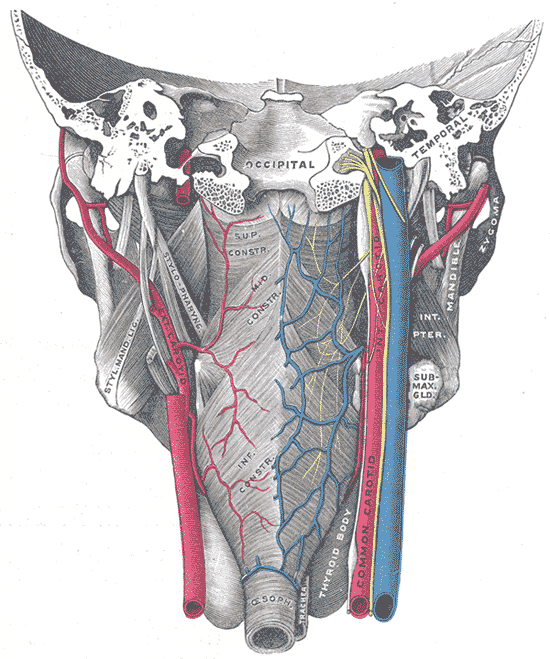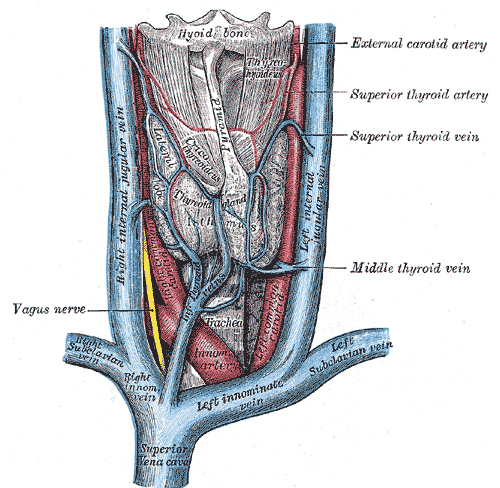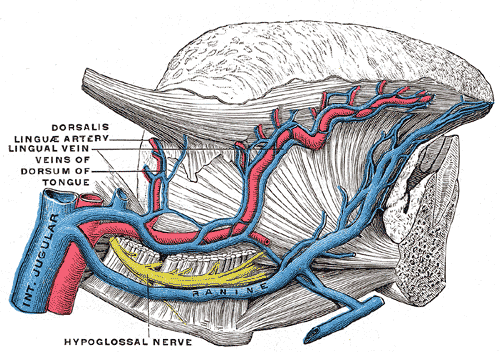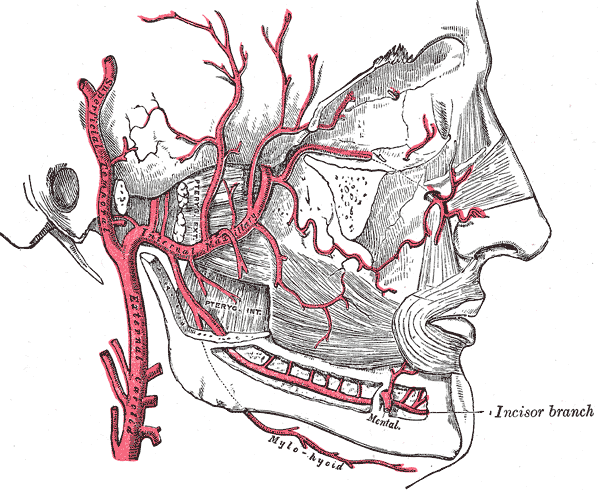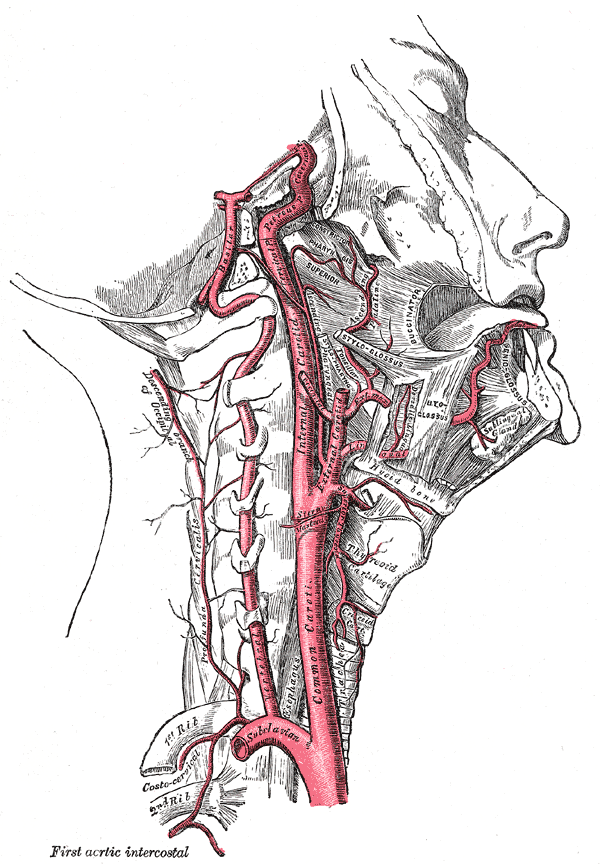One of the two terminal branches of the common carotid artery, the external carotid artery (the other being the internal carotid artery) supplies the structures within the scalp, face neck, tongue and maxilla. The artery extends from the upper border of the thyroid cartilage to the substance of the parotid gland, located behind the neck of mandilble, where it divides into two terminal branches:
1. Superficial temporal artery
2. Maxillary artery
Grey’s Anatomy 20th edition
The pulsations of the artery can be felt within the carotid triangle located at its origin. Initially the artery is located medial to the internal carotid artery but as it moves upwards in the neck, it travels backwards and laterally.
The stylohyoid and posterior belly of digastric cross the common carotid artery.
Relations:
Anterolaterally:
The anterior border of sternocleidomastoid overlaps the artery at its beginning. Only skin and fascia cover the artery above this level, as the artery becomes superficial. The stylohyoid muscle, the posterior belly of digastric and hypoglossal nerve cross the artery, while the facial nerve crosses the artery within the parotid gland. Initially the internal jugular vein is located lateral to the artery but then it moves posteriorly.
Medially:
The internal carotid artery and the wall of the pharynx is located medially. Also present between the external and internal carotid arteries are the pharyngeal branch of vagus nerve, the glossopharyngeal nerve and the stylopharyngeus muscle.
Grey’s Anatomy 20th edition
Branches:
Grey’s Anatomy 20th edition
Arising from anterior aspect:
1. Superior thyroid artery:
The superior thyroid artery arises near the origin of the external carotid artery. It reaches the upper pole of the thyroid gland by passing vertically downwards.
Branches:
1. Branch to sternocleidomastoid
2. Superior laryngeal artery
The superior laryngeal artery, along with the internal laryngeal nerve, pierces the thyrohyoid membrane.
Grey’s Anatomy 20th edition
2. Lingual artery
The lingual artery begins opposite the tip of greater cornu of hyoid bone and enters the submandibular region by looping upwards. This loop of the artery is crossed by the hypoglossal nerve superficially. The lingual artery moves forward deep to hyoglossus muscle and supplies the tip of the tongue.
Branches:
1. Dorsal lingual branches
These supply the dorsum of the tongue and are two or three in number.
2. Sublingual artery
As the name indicates it supplies the sublingual salivary gland and the surrounding structures.
Grey’s Anatomy 20th edition
3. Facial artery
Originates just above the level of the tip of the greater cornu of hyoid bone. It supplies the face, reaching the posterior part of the submandibular salivary gland by arching upwards. It grooves the posterior border of the submandibular salivary gland. At the anterior border of the masseter muscle, the facial artery curves around the inferior margin of the body of mandible. The pulsations of the artery can be felt here. The artery, covered by risorius muscle and platysma moves towards the angle of the mouth by following a tortuous course. The facial artery moves deep to levator labii superioris muscles and reaches the medial angle of the eye by running along the side of the nose. Here the artery anastomoses with the branches of the ophthalmic artery.
Branches:
Branches within submandibular region
1. Ascending palatine artery
The ascending palatine artery moves alongside the pharynx.
2. Tonsillar artery
The tonsillar artery supplies the tonsil and perforates the superior constrictor muscle.
3. Glandular artery
The glandular artery supplies the submandibular salivary gland.
4. Submental artery
Supplies the lip and skin of chin and arises at the lower border of the body of mandible.
Branches supplying the Face
5. Superior labial artery
Supplies the septum and the ala of the nose by arising near the angle of the mouth and running medially in the upper lip.
6. Inferior labial artery
Like the superior labial artery, arises near the angle of the mouth and runs medially but in the lower lip. It anastomoses with its counter part on the opposite site.
7. Lateral nasal artery
The lateral nasal artery supplies the dorsum and side of nose originating from the facial artery alongside the nose.
Grey’s Anatomy 20th edition
Arising from medial aspect:
4. Ascending pharyngeal artery
The ascending pharyngeal artery supplies the wall of the pharynx as it moves upwards on it.
Arising from posterior aspect:
5. Occipital artery
The occipital artery arises just above the level of the tip of greater cornu of hyoid bone, opposite the facial artery. It reaches the back of the scalp by passing upwards. It supplies the scalp along with the branches of greater occipital nerve.
6. Posterior auricular artery
The posterior auricular artery reaches the auricle, originating at the level of the upper border of posterior belly of digastric.
Terminal branches:
7. Superficial temporal artery
The superficial temporal artery arises within the substance of the parotid gland at the level of neck of mandilbe. It is accompanied by the auriculotemporal nerve as it moves upwards in front of the auricle. It then divides into two branches; the anterior and posterior branches to supply the skin of the temporal and frontal regions.
8. Maxillary artery
The maxillary artery arises within the substance of the parotid gland at the level of the neck of mandible. It is the larger of the two terminal branches. It moves upwards and forward, located superficial or deep to the lower head of the lateral pterygoid. It enters the pterygopalatine fossa by leaving the infratemporal fossa, passing through the pterygomaxillary fissure. Here it divides into branches which are accompanied by the branches of the maxillary nerve.
Branches within Infratemporal fossa
1. Inferior alveolar artery
The inferior alveolar artery enters the mandibular canal following the inferior alveolar nerve.
2. Middle meningeal artery
The middle meningeal artery moves behind the mandibular nerve and it surrounded by the two roots of origin of the auriculotemporal nerve. Passing through the foramen spinosum, it enters the skull and supplies the meninges.
3. Branches supplying the tympanic membrane and the lining of the external auditory meatus.
4. Muscular branches supplying the muscles of mastication.
Branches within Pterygopalatine fossa
5. Posterior superior alveolar artery
6. Infraorbital artery
7. Greater palatine artery
8. Sphenopalatine artery
9. Pharyngeal branch
Grey’s Anatomy 20th edition
 howMed Know Yourself
howMed Know Yourself

